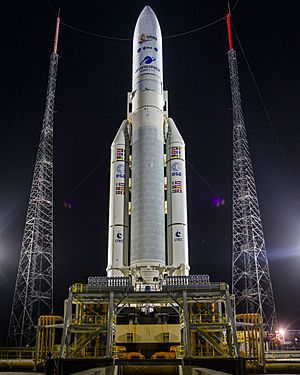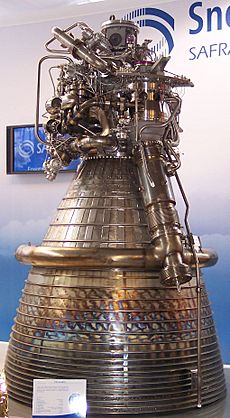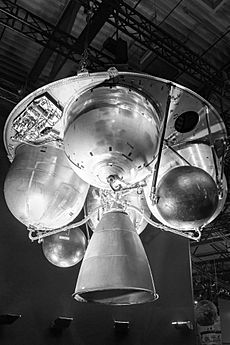Ariane 5 facts for kids

Ariane 5 flight VA-256 on the launch pad with the James Webb Space Telescope in December 2021
|
|
| Function | Heavy launch vehicle |
|---|---|
| Manufacturer | ArianeGroup for ESA |
| Country of origin |
20 ESA member states:
|
| Cost per launch | €150–200 million (as of 2016) |
| Size | |
| Height | 46–52 m (151–171 ft) |
| Diameter | 5.4 m (18 ft) |
| Mass | 777,000 kg (1,713,000 lb) |
| Stages | 2 |
| Capacity | |
| Payload to Low Earth orbit | G: 16,000 kg (35,000 lb) ES: over 20,000 kg (44,000 lb) |
| Payload to GTO |
|
| Associated rockets | |
| Family | Ariane |
| Comparable |
|
| Launch history | |
| Status |
|
| Launch sites | Centre Spatial Guyanais, ELA-3 |
| Total launches | 117
|
| Successes | 112
|
| Failures | 2 (G: 1, ECA: 1) |
| Partial failures | 3 (G: 2, ECA: 1) |
| First flight |
|
| Last flight |
|
| Notable payloads | |
| Boosters (G, G+) – EAP P238 | |
| No. boosters | 2 |
| Length | 31.6 m (104 ft) |
| Diameter | 3.06 m (10.0 ft) |
| Gross mass | 270 t (270 long tons; 300 short tons) |
| Engines | P238 |
| Thrust | 6,650 kN (1,490,000 lbf) |
| Total thrust | 13,300 kN (3,000,000 lbf) |
| Burn time | 130 seconds |
| Fuel | AP, Aluminium, HTPB |
| Boosters (GS, ECA, ES) – EAP P241 | |
| No. boosters | 2 |
| Length | 31.6 m (104 ft) |
| Diameter | 3.06 m (10.0 ft) |
| Empty mass | 33 t (32 long tons; 36 short tons) |
| Gross mass | 273 t (269 long tons; 301 short tons) |
| Engines | P241 |
| Thrust | 7,080 kN (1,590,000 lbf) |
| Total thrust | 14,160 kN (3,180,000 lbf) |
| Burn time | 140 seconds |
| Fuel | AP, Aluminium, HTPB |
| Core stage (G, G+, GS) – EPC H158 | |
| Length | 23.8 m (78 ft) |
| Diameter | 5.4 m (18 ft) |
| Empty mass | 12,200 kg (26,900 lb) |
| Gross mass | 170,500 kg (375,900 lb) |
| Engines | G, G+: Vulcain 1 GS: Vulcain 1B |
| Thrust | 1,015 kN (228,000 lbf) (vacuum) |
| Specific impulse | 440 seconds (vacuum) |
| Burn time | 605 seconds |
| Fuel | LH2 / LOX |
| Core stage (ECA, ES) – EPC H173 | |
| Length | 23.8 m (78 ft) |
| Diameter | 5.4 m (18 ft) |
| Empty mass | 14,700 kg (32,400 lb) |
| Gross mass | 184,700 kg (407,200 lb) |
| Engines | Vulcain 2 |
| Thrust | 960 kN (220,000 lbf) (sea level) 1,390 kN (310,000 lbf) (vacuum) |
| Specific impulse | 310 seconds (sea level) 432 seconds (vacuum) |
| Burn time | 540 seconds |
| Fuel | LH2 / LOX |
| Second stage (G) – EPS L9.7 | |
| Length | 3.4 m (11 ft) |
| Diameter | 5.4 m (18 ft) |
| Empty mass | 1,200 kg (2,600 lb) |
| Gross mass | 10,900 kg (24,000 lb) |
| Engines | Aestus |
| Thrust | 27 kN (6,100 lbf) |
| Burn time | 1100 seconds |
| Fuel | MMH / N2O4 |
| Second stage (G+, GS, ES) – EPS L10 | |
| Length | 3.4 m (11 ft) |
| Diameter | 5.4 m (18 ft) |
| Empty mass | 1,200 kg (2,600 lb) |
| Gross mass | 11,200 kg (24,700 lb) |
| Engines | Aestus |
| Thrust | 27 kN (6,100 lbf) |
| Burn time | 1170 seconds |
| Fuel | MMH / N2O4 |
| Second stage (ECA) – ESC-A | |
| Length | 4.711 m (15.46 ft) |
| Diameter | 5.4 m (18 ft) |
| Empty mass | 4,540 kg (10,010 lb) |
| Gross mass | 19,440 kg (42,860 lb) |
| Engines | HM7B |
| Thrust | 67 kN (15,000 lbf) |
| Specific impulse | 446 seconds |
| Burn time | 945 seconds |
| Fuel | LH2 / LOX |
Ariane 5 was a European heavy-lift space launch vehicle developed and operated by Arianespace for the European Space Agency (ESA). It was launched from the Centre Spatial Guyanais (CSG) in French Guiana. It had been used to deliver payloads into geostationary transfer orbit (GTO) or low Earth orbit (LEO). The launch vehicle had a streak of 82 consecutive successful launches between 9 April 2003 and 12 December 2017. Since 2014, Ariane 6, a direct successor system, is in development.
The system was designed as an expendable launch system by the Centre national d'études spatiales (CNES), the French government's space agency, in cooperation with various European partners. Despite not being a direct derivative of its predecessor launch vehicle program, it is classified as part of the Ariane rocket family. ArianeGroup is the prime contractor for the manufacturing of the vehicles, leading a multi-country consortium of other European contractors. Ariane 5 was originally intended to launch the Hermes spacecraft, and thus it is rated for human space launches.
Since its first launch, Ariane 5 was refined in successive versions: "G", "G+", "GS", "ECA", and finally, "ES". The system had a commonly used dual-launch capability, where up to two large geostationary belt communication satellites can be mounted using a SYLDA (Système de Lancement Double Ariane, meaning "Ariane Double-Launch System") carrier system. Up to three, somewhat smaller, main satellites are possible depending on size using a SPELTRA (Structure Porteuse Externe Lancement Triple Ariane, which translates to "Ariane Triple-Launch External Carrier Structure"). Up to eight secondary payloads, usually small experiment packages or minisatellites, can be carried with an ASAP (Ariane Structure for Auxiliary Payloads) platform.
Following the launch of 15 August 2020, Arianespace signed the contracts for the last eight Ariane 5 launches, before it is succeeded by the new Ariane 6 launcher, according to Daniel Neuenschwander, director of space transportation at the ESA.
Contents
Vehicle description
Cryogenic main stage
Ariane 5's cryogenic H173 main stage (H158 for Ariane 5G, G+, and GS) is called the EPC (Étage Principal Cryotechnique — Cryotechnic Main Stage). It consists of a 5.4 m (18 ft) diameter by 30.5 m (100 ft) high tank with two compartments, one for liquid oxygen and one for liquid hydrogen, and a Vulcain 2 engine at the base with a vacuum thrust of 1,390 kN (310,000 lbf). The H173 EPC weighs about 189 t (417,000 lb), including 175 t (386,000 lb) of propellant. After the main cryogenic stage runs out of fuel, it re-enters the atmosphere for an ocean splashdown.
Solid boosters
Attached to the sides are two P241 (P238 for Ariane 5G and G+) solid rocket boosters (SRBs or EAPs from the French Étages d'Accélération à Poudre), each weighing about 277 t (611,000 lb) full and delivering a thrust of about 7,080 kN (1,590,000 lbf). They are fueled by a mix of ammonium perchlorate (68%) and aluminium fuel (18%) and HTPB (14%). They each burned for 130 seconds before being dropped into the ocean. The SRBs are usually allowed to sink to the bottom of the ocean, but, like the Space Shuttle Solid Rocket Boosters, they can be recovered with parachutes, and this has occasionally been done for post-flight analysis. Unlike Space Shuttle SRBs, Ariane 5 boosters are not reused. The most recent attempt was for the first Ariane 5 ECA mission in 2009. One of the two boosters was successfully recovered and returned to the Guiana Space Center for analysis. Prior to that mission, the last such recovery and testing was done in 2003.
The French M51 submarine-launched ballistic missile (SLBM) shares a substantial amount of technology with these boosters.
In February 2000, the suspected nose cone of an Ariane 5 booster washed ashore on the South Texas coast, and was recovered by beachcombers before the government could get to it.
Second stage
The second stage is on top of the main stage and below the payload. The original Ariane — Ariane 5G — used the EPS (Étage à Propergols Stockables — Storable Propellant Stage), which was fueled by monomethylhydrazine (MMH) and nitrogen tetroxide, containing 10,000 kg (22,000 lb) of storable propellant. The EPS was subsequently improved for use on the Ariane 5G+, GS, and ES.
The EPS upper stage was capable of repeated ignition, first demonstrated during flight V26 which was launched on 5 October 2007. This was purely to test the engine, and occurred after the payloads had been deployed. The first operational use of restart capability as part of a mission came on 9 March 2008, when two burns were made to deploy the first Automated Transfer Vehicle (ATV) into a circular parking orbit, followed by a third burn after ATV deployment to de-orbit the stage. This procedure was repeated for all subsequent ATV flights.
Ariane 5ECA uses the ESC (Étage Supérieur Cryotechnique — Cryogenic Upper Stage), which is fueled by liquid hydrogen and liquid oxygen. The ESC uses the HM7B engine previously used in the Ariane 4 third stage. The propellent load of 14.7 tonne allows the engine to burn for 945 seconds while providing 6.5 tonne of thrust. The ESC provides roll control during powered flight and full attitude control during payload separation using hydrogen gas thrusters. Oxygen gas thrusters allowed longitudinal acceleration after engine cutoff. The flight assembly includes the Vehicle Equipment Bay, with flight electronics for the entire rocket, and the payload interface and structural support.
Fairing
The payload and all upper stages were covered at launch by a fairing for aerodynamic stability and protection from heating during supersonic flight and acoustic loads. It was jettisoned once sufficient altitude has been reached, typically above 100 km (62 mi). It was made by Ruag Space and since flight VA-238 it is composed of 4 panels.
Variants
| Variant | Description |
|---|---|
| G | The original version is dubbed Ariane 5G (Generic) and had a launch mass of 737 t (1,625,000 lb). Its payload capability to geostationary transfer orbit (GTO) was 6,900 kg (15,200 lb) for a single satellite or 6,100 kg (13,400 lb) for dual launches. It flew 17 times with one failure and two partial failures. |
| G+ | The Ariane 5G+ had an improved EPS second stage, with a GTO capacity of 7,100 kg (15,700 lb) for a single payload or 6,300 kg (13,900 lb) for two. It flew three times in 2004, with no failures. |
| GS | At the time of the failure of the first Ariane 5ECA flight in 2002, all Ariane 5 launchers in production were ECA versions. Some of the ECA cores were modified to use the original Vulcain engine and tank volumes while the failure was investigated; these vehicles were designated Ariane 5GS. The GS used the improved EAP boosters of the ECA variant and the improved EPS of the G+ variant, but the increased mass of the modified ECA core compared to the G and G+ core resulted in slightly reduced payload capacity. Ariane 5GS could carry a single payload of 6,600 kg (14,600 lb) or a dual payload of 5,800 kg (12,800 lb) to GTO. The Ariane 5GS flew 6 times from 2005 to 2009 with no failures. |
| ECA | The Ariane 5ECA (Evolution Cryotechnique type A), first successfully flown in 2005, uses an improved Vulcain 2 first-stage engine with a longer, more efficient nozzle with a more efficient flow cycle and denser propellant ratio. The new ratio required length modifications to the first-stage tanks. The EPS second stage was replaced by the ESC-A (Etage Supérieur Cryogénique-A), which has a dry weight of 4,540 kg (10,010 lb) and is powered by an HM-7B engine burning 14,900 kg (32,800 lb) of cryogenic propellant. The ESC-A uses the liquid oxygen tank and lower structure from the Ariane 4's H10 third stage, mated to a new liquid hydrogen tank. Additionally, the EAP booster casings were lightened with new welds and carry more propellant. The Ariane 5ECA started with a GTO launch capacity of 9,100 kg (20,100 lb) for dual payloads or 9,600 kg (21,200 lb) for a single payload. Later batches: PB+ and PC, increased the max payload to GTO to 11,115 kg (24,504 lb). |
| ES | The Ariane 5ES (Evolution Storable) has an estimated LEO launch capacity of 21,000 kg (46,000 lb). It includes all the performance improvements of Ariane 5ECA core and boosters but replaces the ESC-A second stage with the restartable EPS used on Ariane 5GS variants. It was used to launch the Automated Transfer Vehicle (ATV) into a 260 km (160 mi) circular low Earth orbit inclined at 51.6° and has been used 3 times to launch 4 Galileo navigation satellites at a time directly into their operational orbit. The Ariane 5ES flew 8 times from 2008 to 2018 with no failures. |
| ME | The Ariane 5ME (Mid-life Evolution) was under development until the end of 2014. The last ESA ministerial council of December 2014 has cut further funding for Ariane 5ME in favour of developing Ariane 6. Last activities for Ariane 5ME were completed at the end of 2015. Activities on development of the VINCI upper stage were transferred to Ariane 6. |
Launch system status: Retired · Cancelled · Operational · Under development
Launch pricing and market competition
As of November 2014[update], the Ariane 5 commercial launch price for launching a "midsize satellite in the lower position" was approximately €50 million, competing for commercial launches in an increasingly competitive market.
The heavier satellite is launched in the upper position on a typical dual-satellite Ariane 5 launch and is priced higher than the lower satellite, on the order of €90 million as of 2013[update].
Total launch price of an Ariane 5 – which can transport up to two satellites to space, one in the "upper" and one in the "lower" positions – was around €150 million as of January 2015[update].
Ariane 6
The design brief of the next generation launch vehicle Ariane 6 called for a lower-cost and smaller launch vehicle capable of launching a single satellite of up to 6,500 kg (14,300 lb) to GTO. However, after several permutations the finalized design was nearly identical in performance to the Ariane 5, focusing instead on lowering fabrication costs and launch prices. As of March 2014[update], Ariane 6 was projected to be launched for about €70 million per flight, about half of the Ariane 5 price.
Initially development of Ariane 6 was projected to cost €3.6 billion. In 2017, the ESA set 16 July 2020 as the deadline for the first flight. As of June 2022, Arianespace expects the maiden flight to occur in 2023.
See also
 In Spanish: Ariane 5 para niños
In Spanish: Ariane 5 para niños
- List of Ariane launches
- Ariane 6, two initial variants
- Heavy-lift launch vehicle
- Comparison of orbital launchers families
- Comparison of orbital launch systems
- Future Launchers Preparatory Programme (ESA, beyond Ariane 5)



